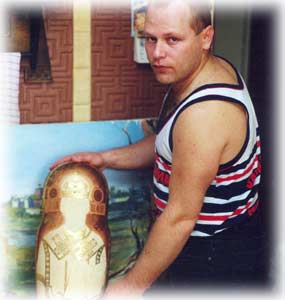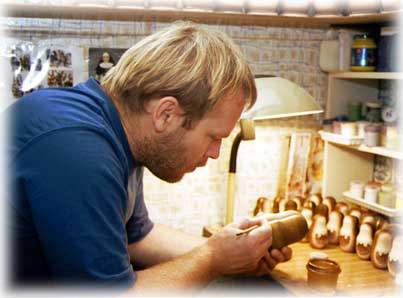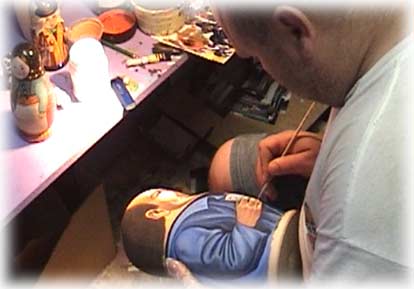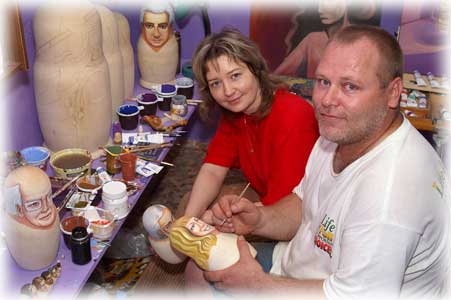Mikhail Yudin makes an interesting case study. Roman met him at the Vernisazh market and began ordering matryoshkas from him in 1994, early in our game. His reliability and integrity, not to mention his winning personality, helped him gain our confidence and our business.
Yudin actually delivered most orders on time or at least showed up on appointed weekends to explain himself. All too often, the artists we encountered at the market were blissfully happy to simply sell the dolls they had finished to the first buying customer, and go home to paint more—even if we had special ordered them a month before. Apparently it didn’t matter to them that we might have customers of our own waiting for their dolls; when Roman sought them out to make the appointed purchase and found them empty handed, they would shrug and say, “I didn’t think you were coming.” So it goes in Russian business; all sorts of headaches are experienced when Western business practices and expectation s are brought to a land that maintains a medieval barter mentality and functions without modern banking or delivery systems. Yudin, unlike the others, understood our game and wanted to play. He delighted in large orders that allowed him to work together with his wife, Margarita, in their Sergiev Posad apartment, and required him to make only infrequent trips to Moscow to meet Roman with a month’s worth of matryoshkas. The orders other artists failed to fulfill we piled upon him with pleas of quick production to meet deadlines, and Yudin delivered, time after time.
s are brought to a land that maintains a medieval barter mentality and functions without modern banking or delivery systems. Yudin, unlike the others, understood our game and wanted to play. He delighted in large orders that allowed him to work together with his wife, Margarita, in their Sergiev Posad apartment, and required him to make only infrequent trips to Moscow to meet Roman with a month’s worth of matryoshkas. The orders other artists failed to fulfill we piled upon him with pleas of quick production to meet deadlines, and Yudin delivered, time after time.
The good rapport between Roman and Yudin grew, and before long his home became a regular stop over point on Roman’s Moscow trips, a sort of base from which he met many area artists.
Aside from their friendship, Roman found Yudin interesting because the artist focused on developing techniques to improve and hasten nesting doll production. Each doll he designed was carefully thought out so that it could be reproduced by hand in reasonably large quantities with maximum efficiency, with sustained quality, and without driving the artist mad from tedious, painstaking details that in the end were not worth the time they demanded. Yudin experimented with and developed several new techniques for finishing his dolls, the most successful being a wax-based lacquer that gives the doll a smooth, satin finish that will protect and preserve essentially forever.
I had become very familiar with his name before I finally met Yudin at the Moscow market in January of 1995. So much of his work has passed through my hands I was very glad to finally meet him and ask him a few of my questions. While sitting in a cold caf?, still wrapped in a fur parka and wearing a brown beard that made him look ever so much like a bear, Yudin gave me a quick glimpse into his world.
Though he ended up in Sergiev Posad, Russia’s “matryoshka capital,” he was born far from it in the Caucasus mountain region of the old Soviet Union, in1966. He began his career in the art world with a position that smacks delightfully of communism: artistic director of a brick factory. During his obligatory stint in the military, he served as artistic designer for the Red Army. Then, after studying a couple years at Moscow’s Surikov Art Institute, Yudin decided he would learn more through experience than study, so left the institute and apprenticed himself first to a master of ceramics, then an iconagrapher, and finally delved into the production of stained glass. By the end of the 1980’s, Yudin was proudly working as master of his own  workshop. But then fortune dealt him a harsh blow: vandals stole his prized works and burned his workshop to the ground. Bereft and discouraged, Yudin had neither the funds nor the heart to rebuild and make a second go of it. It was a critical moment in his life; the oblivion of existence in the gutter seemed dangerously close to him. Then, in 1991, a door opened when a friend suggested he try his skilled hand at painting matryoshkas. An eager Western market created a great demand for dolls, and Yudin had the time and talent and needed the money: it was a no brainer!
workshop. But then fortune dealt him a harsh blow: vandals stole his prized works and burned his workshop to the ground. Bereft and discouraged, Yudin had neither the funds nor the heart to rebuild and make a second go of it. It was a critical moment in his life; the oblivion of existence in the gutter seemed dangerously close to him. Then, in 1991, a door opened when a friend suggested he try his skilled hand at painting matryoshkas. An eager Western market created a great demand for dolls, and Yudin had the time and talent and needed the money: it was a no brainer!
He quickly sold his first dolls, reveled in the immediate success, and started to paint more, a cycle that has now carried him and his small family a dozen years down the road, a road that happened to lead him away from Moscow. In 2001, Yudin and Margarita accepted positions as overseers of production at Golden Cockerel’s growing matryoshka workshop in St. Petersburg, Peter the Great’s “Venice of the North.” There, Yudin plays the role of artistic designer once again, and spends much of his time teaching a whole team of artisans his time-proven production techniques.
As supervisor of a workshop, Yudin has found stability and job security that is rare in the Russian arts and crafts business. He no longer needs to waste precious time and energy making weekly treks to the Moscow market in search of buyers for his goods, nor in haggling over prices to be sure his time invested is recovered. Now he and his team are loaded with not only enough orders to keep them happily occupied, but with challenging projects that push their talents and skills in new directions. Despite the fact that he has made a zillion nesting dolls, sending each one out into the world with his signature, Yudin seems always ready and eager to take on new orders, to push forward the development of nesting doll design and production techniques. When inspired with a new challenge, the true artist comes out in him and he becomes oblivious of clock and calendar, working hours on end, actually days on end, with minimal sleep, without leaving the workshop floor until the project is brought to a successful end. Then there is time enough for sleep, and to slip away to Lake Ladoga in the northern woods to fish for pike and refresh the soul.
A year beforeYudin relocated to St. Petersburg I had the chance to interview him at length. Unlike our first brief meeting, this time we conversed in the relative comfort of his cramped Sergiev Posad apartment made smaller by hundreds of nesting dolls in sacks and scattered about in various stages of production. I found his insights and attitudes toward nesting doll production revealing; they offer a unique glance at matryoshka making from one who has linked his life so closely to Matryoshka and has experienced the market inside out.
The Author: What do most Russian folk think about matryoshka dolls?
Yudin: Many people here think that a matryoshka is just a plaything, a bit of nonsense, and that the people working on matryoshkas are not real workers, but idle good for nothings who don’t want to work. Nothing could be further from the truth. These people are simply ignorant and don’t know anything about it. Anyone who is close to the nesting doll market understands the value of the dolls. Even my little daughter knows that matryoshkas are things to be respected, that they bring us wealth. Many people have no idea how much work goes into the dolls, and so they don’t appreciate them.
Take a moment to look at the chain of people involved in matryoshka production and you realize that the matryoshka is a thing of gold. One person has to harvest the trees, then the trees must be cured for years, then they must be carved, then they must be taken to market, using the transportation system, which uses gasoline. The turner must rent a booth at the market, then sells the dolls to the artist, who also used the transportation system to get to the market, which used more gasoline. And the artist buys paints and brushes, then travels home again, paints the dolls, then back to the market using the transportation system again. This time he rents a booth at the market and sells the dolls to a merchant, who also paid his way to the market and home again, and the merchant or exporter pays taxes on the dolls and pays air freight to get them to America. By the time the matryoshka dolls have made it to America, they’ve gotten quite expensive and have fed many people all along the way.
In order to be a productive matryoshka maker, one must swear off vodka (I suppose one drunk a month is acceptable), live without normal sleep (it would be quite normal to get only 4-5 hours of sleep per night), and finally, one must give up one’s personal life. One works so hard and gets so tired, the normal pleasures of life are forgotten. Occasionally, regardless of how tired one is, one needs to find time for the family and the wife.
Another problem: you work on them for four or five days solid and your quality begins to slip, your technique gets lazy, it gets very difficult to continue. Nobody knows about that. They see a pretty smiling girl in a slick catalog and have no idea how much sweat and energy goes into making those smiling faces.
And it’s quite cheap work, too. The people of Polkhovski Maidan can make 200 five-piece six-inch dolls per week—that’s 1000 pieces they must carve—and they sell them for next to nothing. They must live in poverty. Well, ok, some of them do have big houses, private workshops, and so on.
I personally only need a one room flat. But as long as I have a little daughter, I need more room for her.
The Author: How much time does it take to paint a typical five-piece, six-inch nesting doll?
Yudin: It’s impossible to measure. A beginner might take a whole month on one doll. If I’m in a good mood and lay out a whole party of 100 dolls at once, I can knock them out in a week. It partly depends on the quality of the blank dolls. First I need to inspect them carefully and cull out the bad ones. Then I sand them smooth, pencil in the outline of the doll I’m going to paint, then paint them, working on 100 at a time, painting the largest doll in each set first.
The Author: How has the market for matryoshka dolls changed lately?
Yudin: Terribly. When the ruble fell [during the economic crisis of summer 1999], everything got more expensive, but the selling price for matryoshkas stayed the same.
The Author: Are there now more or fewer artists?
Yudin: Fewer. The market has gotten smaller, the profits less. The artists find other work. Back in 1992 or 1993 when I started selling at Vernisazh, there must have been about 25,000 artists coming from all over Russia, from the Ukraine, from Byelorussia, from Novgorod, Pskov, Siberia, from all over. Now I estimate there are about 6,000 to 7,000 artists selling at Vernisazh.
The Author: Do you have your own doll collection?
Yudin: I don’t have any dolls of my own. But there are also no paintings on the walls that I painted. I prefer to see the drawings of my daughter than my own work.
The Author: What does your daughter think of you painting nesting dolls?
Yudin: She has a good appreciation of my work and greatly appreciates the time and work that goes into each doll. Even when she was too young to speak, she never got into our dolls to play with them. I am the one around here who destroys dolls. I start out painting in a good mood, trying hard—paint, paint, paint—and I begin to think that I’ll never sell the doll for what I think it’s worth to me, and I begin to get sloppy and cut corners, and that depresses me, to be producing something beneath my talent, so sometimes I get angry and simply destroy the doll I’m working on.
The Author: If you were to write a book about nesting dolls, what would you write about?
Yudin: About how hard they are to make. I’d not necessarily write about how dear or how beautiful they are, but about how difficult they are to make, what tedious, painstaking work it takes, how producing them damages one’s eyesight, lungs, and health in general. The lacquer is quite harmful. I used to be in great shape and exercised a lot. Now I can’t even run to the catch the subway. My lungs give out. I attribute that not to the fact that I smoke, but to the lacquer fumes in my lungs. All the materials connected to making matryoshkas are harmful—the lacquer, the wood dust I breathe when I sand blank dolls, the paint fumes and dust, and so on. It seems to me that people in the matryoshka business will have very short lives.
I have never seen any publicity about matryoshkas, never on TV. It is a good thing that you are writing a book. The matryoshka trade has given a group of people the ability to live normally. Unfortunately, in our society, there are others who don’t want to work. When they see someone doing well for themselves, they grab hold like leeches. It’s “Hey buddy, give me half!”
The Author: I see that you specialize in dolls that fall in a middle price range, not the cheapest, and not the most expensive; why is that?
Yudin: I cannot get a high enough return for my time when I paint truly exquisite pieces. I learned that very early on. I would paint a nice doll and be selling next to someone who painted a similar doll, but in a simpler, more primitive style. The tourists would glance at my doll and then at his doll and couldn’t understand why I was charging so much more for mine.
On the other hand, I don’t want to waste my time painting really cheap floral dolls. There are plenty of people who have no artistic ability at all who slap paint on a doll, make a nice face on the top doll only, and sell them for next to nothing.
I can make more money for my time by designing unique dolls that are simple enough for me to paint quickly, but that cannot be easily copied by just anyone. I add metallic foil and my satin-wax finish to make them more unique.
ou can look at it this way: there are three categories of artists selling dolls at Vernisazh. The majority, let’s say 60%, belongs to category three. These folks have no artistic training and are unfamiliar with the subtle techniques of painting and therefore produce very simple, crude dolls. They’re just folks who need to do something to make some money. In my opinion, they live pathetic lives. They arrive at the market on the weekends, have a good drink, sell their dolls, go home and celebrate with another good drink, then spend four or five days to make some more dolls, then go back to the market and start drinking again. That’s their whole lives, in a nutshell. They’re glad enough to have a TV for watching an occasional movie to provide a distraction, to have a sofa to sleep on, and four walls to keep out the snow. The thought of going to the theater, to concerts, to a museum of sculpture, etc., never occurs to them; such things are simply outside their lives.
As for myself, there is no doubt in my mind that painting matryoshkas is not my life, it is my work. Nor do I consider it a fine art. Painting a landscape is a completely different thing for me, however. I walk for miles out into the woods, stand for four or five hours, or even ten hours, working on a painting, and I forget about everything, about food, about everything. True, I do smoke a lot while I paint. But I get lost in the process of painting the landscape. It’s a true pleasure.
Nor do I consider it a fine art. Painting a landscape is a completely different thing for me, however. I walk for miles out into the woods, stand for four or five hours, or even ten hours, working on a painting, and I forget about everything, about food, about everything. True, I do smoke a lot while I paint. But I get lost in the process of painting the landscape. It’s a true pleasure.
I consider myself a member in the second category of artists: trained artists who use their talents to make a living painting nesting dolls. My concept of a matryoshka: it should be a piece of quality craftsmanship, and it should be designed so that I can paint many of them quickly, and so I can take large orders for them. When it comes to matryoshkas, I perceive myself more as a craftsman with a job to complete than an “artist.”
The first category of artists is a very small group. Members in this category consider themselves great artists, and their matryoshkas are masterpieces. They work on them forever, 24 hours in a session, and sell them for a fortune. These folks are generally very skinny. They embellish even the smallest of details.
I don’t believe a real matryoshka masterpiece has ever been created, or ever will be. Perhaps in the next century.
Personally, I’m not such a matryoshka fanatic that I could put so much of myself in the dolls. I’ve got my landscapes for that.
The Author: But at the same time I know you’ve been working on a deluxe twenty piece doll for months, whenever you feel inspired.
Yudin: Yes, that’s true. I suppose I’m a bit envious of these rare artist types and want to make such a beautiful doll myself that will make people stop and stare at a fantastic one-of-a-kind work.
The Author: Will you sell it?
Yudin: I’ll never be able to sell it for what it will have cost me in time. I suppose I’ll simply make a present of it to someone. Some works of art are too valuable to sell and must be given as gifts, free of charge.
Text and Interview Translation: Walton Conway